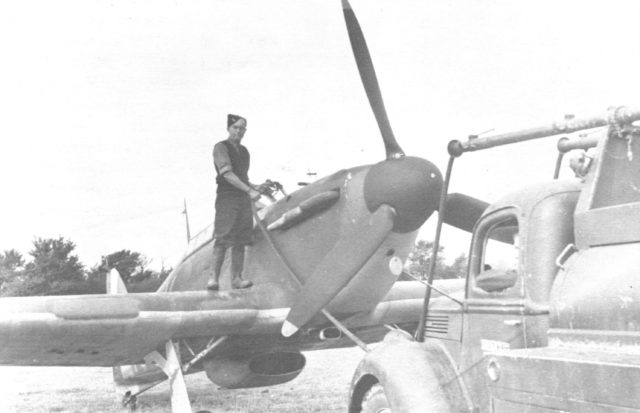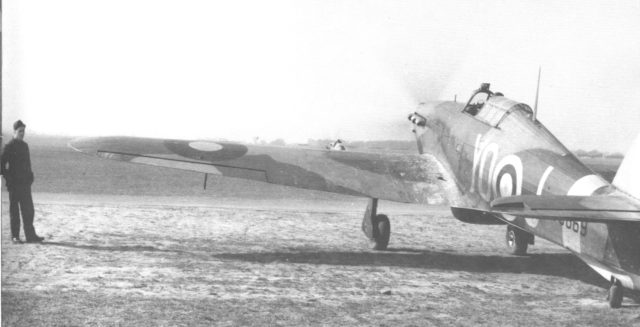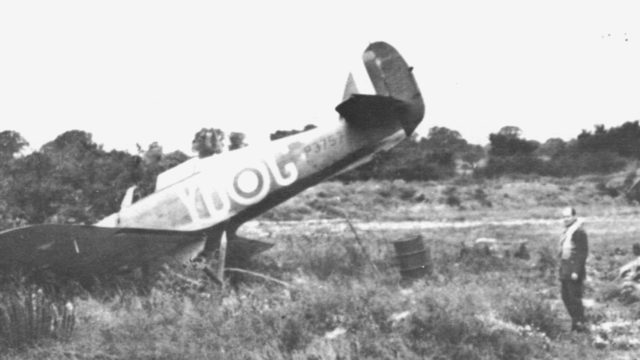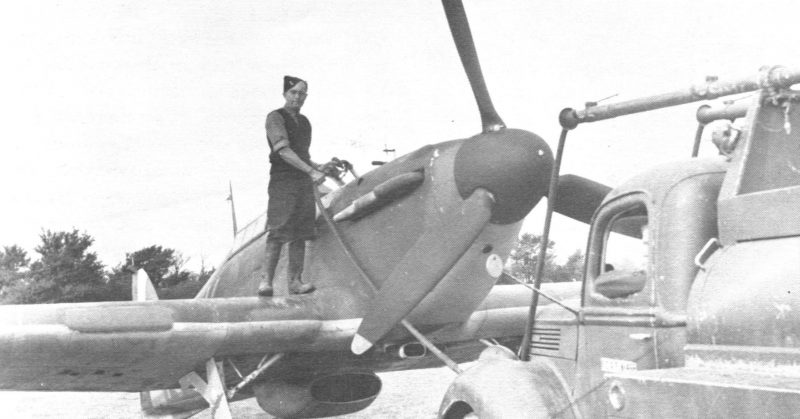War History Online Presents Part one of the guest Blog from Chris Charland.
The 15th of September 1940 was undoubtedly the decisive turning point in the Battle of Britain, as 56 Luftwaffe aircraft were shot down over the south of England. This one-day tally convinced Adolph Hitler, of Germany, that the Luftwaffe could not gain aerial superiority over the English Channel. Swift control of the waters that separated England from France was vital for the Austrian ‘Little Corporal’s’ proposed invasion of England known as ‘Unternehmen Seelowe’ (Operation Sea Lion) that year.
Unfortunately for him, the British thumbed their noses and threw a monkey wrench into the cogs of the German war machine. Today we celebrate Battle of Britain Sunday with a parade heralding the courage of those who flew off to face seemingly insurmountable odds while dueling with the Luftwaffe, and to honour the memories of those who met their fate in the skies over England, and never returned.
* Canadians played a significant role in the demise of the Luftwaffe, as members of the Royal Air Force, especially No. 242 (Canadian) Squadron, R.A.F. and No. 1 (Fighter) Squadron, Royal Canadian Air Force.
Johnny Canuck Joins the RAF
No. 242 Squadron, the R.A.F.’s ‘All Canadian’ unit, which was originally a coastal reconnaissance unit in the First World War, was re-formed on the 30th of October 1939, at R.A.F. Station Church Fenton, Yorkshire. It comprised Canadian aircrew serving in the R.A.F. prior to the Second World War. Initial training commenced in November with a compliment of three Miles Magisters (from No.’s 53 and 66 Squadrons), a single North American Harvard Mk.1 (on loan from No.609 Squadron) and a Fairey Battle Mk.1.(from No.235 Squadron). These numbers were added to by the arrival of seven twin-engine Bristol Blenheim Mk.1F’s and three more single-engine Fairey Battle Mk.1’s in December 1939.

No.242 Squadron received the Hawker Hurricane Mk.1 in March 1940. On the 23rd of March 1940, under command of Squadron Leader Fowler Morgan Gobeil of Ottawa, No.242 (Canadian) Squadron was declared operational for daytime operations. It was cleared to fly night ops the following month on the 11th of May. The unit’s first operational sortie was flown on the 25th of March 1940, when ‘A’ Flight comprising seven Hurricanes flew a convoy patrol.
First Blood
The first Canadian from No.242 Squadron to die in action was Flight Lieutenant John Lewis Sullivan of Smiths Falls, Ontario. On the 14th of May, 1940, he was shot down in Hurricane Mk. I s/n P2621 by a Luftwaffe Hs-123 near Gorroy-le-Chateau, while providing air cover for the evacuation of the beaches at Dunkirk France. Ten pilots of ‘A’ Flight were sent to France on the 16th of May 1940 where they flew with No.’s 607 ‘County of Durham’ and 615 ‘County of Surrey’ fighter squadrons.
By the time the Canadians returned from France, albeit a brief respite from combat, they had accounted for 6 enemy aircraft destroyed. In addition to the death of F/L Sullivan, one squadron member became a Prisoner Of War (Flying Officer Lorne Edward Chambers of Vernon, B.C.) while two others were wounded (Pilot Officer’s Marvin Kitchener Brown of Kincardine, Ontario and Russell Henry Wiens of Jansen, Saskatchewan).
An R.C.A.F. First
No. 242 (Canadian) Squadron reported to RAF Station Biggin Hill, Kent on the 21st of May 1940. The following day, eight of the units Hurricanes shot down a trio of Henschel Hs 126B-1 army co-operation aircraft near Arras, France.
This was a great morale booster, for the squadron up to that point had lost several members in combat without avenging their losses. The honour of the first victory by a member of the R.C.A.F. went to No.242 Squadron’s commanding Officer S/L Gobeil. He shot down a twin-engine Bf 110C ‘Zerstorer’ on the 25th of May.

French Adventures
After numerous patrols, encounters and incidents, No.242 (Canadian) Fighter Squadron in its entirety, was sent back to France. They arrived at Le Mans on the 8th of June, accompanied by the Royal Air Force’s No.17 (F) Squadron. The squadron was in the thick of things. They were on the doorstep of the advancing Germans. The situation was one of desperation. The Germans were literally steam-rolling over the hapless British and French forces. No. 242 (RCAF) Fighter Squadron provided a rear-guard action to allow the British forces time to retreat which would soon lead to the wholesale evacuation from the beaches of Dunkirk. While in France, they moved about from Chateaudun to Ancenis and finally, Nantes.
With little hope of saving France, the Canadians continued to fly on into the face of adversity. It was a lost cause to say the least. On the 18th of June 1939, the last of the pilots flew back to an England which was recovering from the embarrassing shock of the loss of so many personnel and much valuable equipment. The remnants of the squadron were re-assembled at R.A.F. Station Coltishall, Norfolk. It was not until the 9th of July, 1940, that No.242 (RCAF) Fighter Squadron was once again operational.
‘Wooden Legged Wonder’
Two days later, the new commanding officer of No. 242 (Canadian) Squadron and soon to be legendary ‘legless’ pilot, Squadron Leader D.R.S. ‘Douglas’ Bader, shot two Luftwaffe Dornier Do 17Z-2’s. The squadron moved again, this time operating from the airfield at R.A.F. Station Duxford, Cambridgeshire.
Here the Canadian fliers got plenty of opportunity to tangle with the Jerries (Germans) to the north and east of London as part of the Duxford Wing. While operating as part of the Wing, No.242 (Canadian) Squadron scored 11 victories on the 5th of September. The unit would continue with great success during many of its heaviest engagements with the intruding Luftwaffe aircraft.

Changes
The engagements became more sporadic to the point where in October, the squadron unsuccessfully tried its hand at night fighting. By the end of the year, No.242 (Canadian) Squadron lost much of its unique national identity. An influx of Polish and Czech pilots who had managed to escape from their German occupied homelands, as well as British, Australian and Free French, brought the ‘Canadian content’ to about fifty percent. By the middle of the following year, the unit had a pronounced international flavour.
Prelude To War
Canada’s one and only regular fighter squadron No.1 (Fighter) Squadron (based at Dartmouth, Nova Scotia), had been a permanent peacetime unit flying the Northrop Delta Mk.II and Hawker Hurricane Mk.1 prior to being called up for active duty overseas on the 22nd of May, 1940. The decision had been made to send an R.C.A.F. fighter squadron to England along with army co-operation air units in support of the 1st Canadian Division, which was being readied for duty in France.
The move overseas was to take place after the unit was amalgamated with Montreal’s No. 115 (Fighter) Squadron (Auxiliary). No. 115 Squadron, mobilised at the outbreak of war, possessed six aircraft, all of which hardly could be considered fighter material (three North American Harvard Mk.I’s and three Fairey Battles) A number of personnel from units based in Nova Scotia (No.s 8, 10 and 11 Bomber Reconnaissance Squadrons) filled in the remaining slots needed to bring No. 1 up to full squadron compliment.
The squadron left Halifax on the 8th of June,1940 aboard the S.S.Duchess of Athol and the Duchess of Bedford. They arrived at Liverpool England on the 20th, where they proceeded to their new home of R.A.F. Station Middle Wallop, Hampshire. The hostilities in France were over and the Battle of Britain was about to begin. The Hawker Hurricanes that the squadron brought over (using the Watts two-bladed wooden fixed-pitch propellers), were not up to R.A.F. specifications. The aircraft were traded back to the R.A.F. for more modern airframes.
The squadron carried out intensive training as the Battle of Britain was being waged all around them. No. 1 (F) Squadron, R.C.A.F. relocated to Croydon, Surrey on the 4th of July, 1940. During this time, the squadron would remain classified as non-operational. All of that was about to change, as on the 17th of August, 1940, No. 1 (F) Squadron was transferred to the Northolt Sector and declared fully operational. The squadron, led by Squadron Leader Ernie McNabb of Rosthern, Saskatchewan was about to go to war.
By Chris Charland
Senior Associate Air Force Historian
